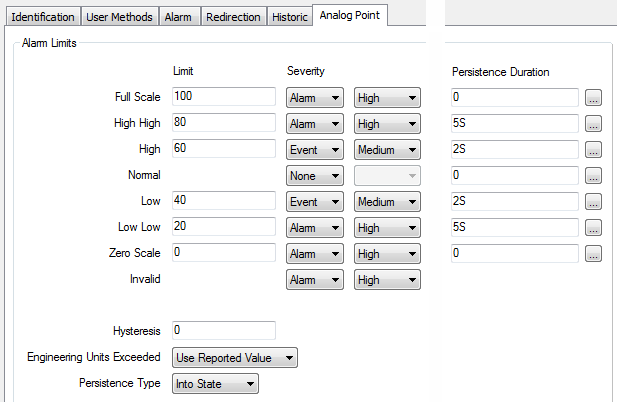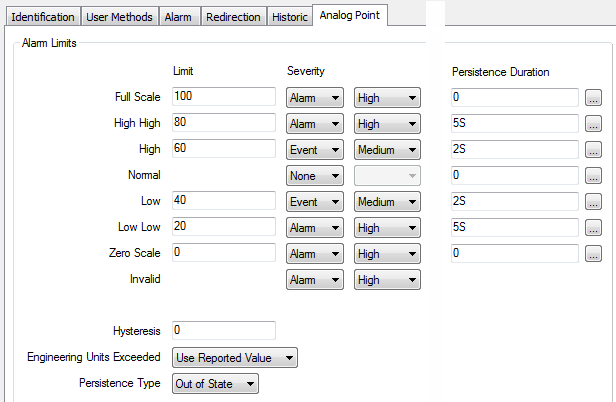NOTE: Persistence will only work when the server read type is synchronous (see Configure OPC DA Server Properties) and the point is configured for Synchronous Polling. Persistence requires the value of a point to be regularly retrieved to check if the value has changed.
These examples demonstrate how persistence might be used on an analog point on the Advanced OPC driver. Additionally, the second part of the Out of State Persistence example illustrates how Significant Change settings affect when the point’s change in value is recorded.
For more information on persistence, (see Use Persistence to Stop Fleeting Changes in Value from Changing a Point State). For more information on Significant Change, see Define the Criteria for a Significant Change in Value in the ClearSCADA Guide to Core Point Configuration.
Example 1 - Into State Persistence:
An analog point has this configuration:

The relevant persistence time begins whenever the analog point’s value crosses a state limit.
The analog point changes value from 50 (Normal state) to 35. A period of 2 seconds has to elapse before the point value and point state (Low) are deemed to have changed and are recorded. This is because the Persistence Duration for the point going into the Low state is specified as 2S (2 seconds).
If, during this two-second period, the point’s value rose back above 40 (back into the Normal state), no change in point value or state would be recorded, as the point would be deemed not to have changed.
If, during the two-second period, the point’s value did not rise, but instead it continued to fall, if it dropped below 20 (the Low Low limit), the persistence timer would restart. A period of 5 seconds would then have to elapse before the point value and state (Low Low) were deemed to have changed and are recorded. This is because the Persistence Duration for the point going into the Low Low state is specified as 5S (5 seconds).
Example 2 - Out of State Persistence:
An analog point has this configuration:

The relevant persistence time begins whenever the analog point’s value crosses a state limit.
The analog point changes value from 50 (Normal state) to 35. As the Normal state’s Persistence Duration is zero, the change in point value and point state (Low) are recorded immediately.
The point’s value continues to fall. The value drops below 20, triggering the Out of State Persistence Duration for the Low limit. This is triggered as soon as the point moves out of the Low state into another state. A period of 2 seconds then has to elapse before the point value and point state (Low Low) are deemed to have changed and are recorded. This is because the Persistence Duration for the point going out of the Low state is specified as 2S (2 seconds).
If, during this two-second period, the point’s value changes further, rising above 20, back into the Low state, the fleeting change in point value and state (to Low Low) would not be recorded, as the point would be deemed not to have changed from the Low state.
If the point’s value continues to rise, once it travels out of the Low state again, it would trigger the Out of State Persistence Duration for that state. It the point remains out of the Low state for the entire 2-second duration, its new state and value would be recorded as that duration elapses. So, if after 2 seconds the point’s value is 75, this value, along with its new state (High) would be recorded.
If the point used these Significant Change settings, along with a Persistence Type of ‘Out of State’:

If the change in point value when the point moved into the Low Low state resulted in a value change that exceeded the Significant Change Deadband, the new value and old state (Low) would be recorded immediately, due to that Deadband being exceeded. (The Deadband in this example is 5% of the point range (Zero Scale to Full Scale).) Additionally, if the point remained out of the old state (Low) for the Persistence Duration of 2S (2 seconds), once that duration had elapsed, the current point value (which might differ from the value that was recorded when the Significant Change Deadband was exceeded) and new state (Low Low) would be recorded. However, if at any stage during the Persistence Duration, the point reverts back to a value greater than 20 (back into the Low state), the fleeting change to the Low Low state would not be recorded.
Similarly, if the change in point value when the point rose out of the Low state resulted in a value change that exceeded the Significant Change Deadband, the new value and old state (Low) would be recorded at that instant. Then when the Low state’s Out of State Persistence Duration has been exceeded, the point’s current value (75 in this example) and state (High) would be recorded.